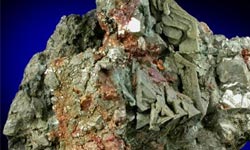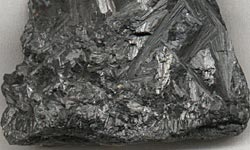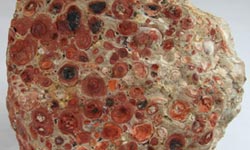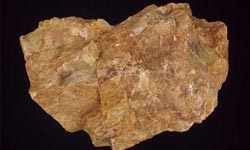| Iron Ore Fines |
 Iron (Fe) is a metallic element and composes about 5% of the Earth’s crust. When pure it is a dark, silvery-gray metal. It is a very reactive element and oxidizes (rusts) very easily. The reds, oranges and yellows seen in some soils and on rocks are probably iron oxides. The inner core of the Earth is believed to be a solid iron-nickel alloy. Iron-nickel meteorites are believed to represent the earliest material formed at the beginning of the universe. Studies show that there is considerable iron in the stars and terrestrial planets: Mars, the "Red Planet," is red due to the iron oxides in its crust.
Iron (Fe) is a metallic element and composes about 5% of the Earth’s crust. When pure it is a dark, silvery-gray metal. It is a very reactive element and oxidizes (rusts) very easily. The reds, oranges and yellows seen in some soils and on rocks are probably iron oxides. The inner core of the Earth is believed to be a solid iron-nickel alloy. Iron-nickel meteorites are believed to represent the earliest material formed at the beginning of the universe. Studies show that there is considerable iron in the stars and terrestrial planets: Mars, the "Red Planet," is red due to the iron oxides in its crust.
|
| Manganese |
 MANG-gən-neez is a chemical element, designated by the symbol Mn. It has the atomic number 25. It is found as a free element in nature (often in combination with iron), and in many minerals. As a free element, manganese is a metal with important industrial metal alloy uses, particularly in stainless steels.
MANG-gən-neez is a chemical element, designated by the symbol Mn. It has the atomic number 25. It is found as a free element in nature (often in combination with iron), and in many minerals. As a free element, manganese is a metal with important industrial metal alloy uses, particularly in stainless steels.
|
| Bauxite Ore |
 Aluminum is a silver-white metal, very light in weight (less than three times as dense as water), yet relatively strong. In addition, aluminum is ductile, that is, it can be drawn into wires or pressed into sheets or foil. It is the most abundant metallic element, and the third most abundant of all elements in the Earth’s crust, making up 8% of the crust by weight. Only silicon and oxygen are more plentiful.
Aluminum is a silver-white metal, very light in weight (less than three times as dense as water), yet relatively strong. In addition, aluminum is ductile, that is, it can be drawn into wires or pressed into sheets or foil. It is the most abundant metallic element, and the third most abundant of all elements in the Earth’s crust, making up 8% of the crust by weight. Only silicon and oxygen are more plentiful.
|
| Feldspar |
 Feldspar is the most common mineral in the Earth’s crust, so you are very likely to find it in the rocks you collect! It is found it all of the three rock types, but is most common in intrusive igneous rocks like granite where the crystals look white or pink. Color can be helpful, but beware because the same mineral can often have different colors. The sure way to tell these two apart is by looking at the crystal surfaces for thin parallel groves called striations. Plagioclase feldspar has striations but orthoclase feldspar does not.
Feldspar is the most common mineral in the Earth’s crust, so you are very likely to find it in the rocks you collect! It is found it all of the three rock types, but is most common in intrusive igneous rocks like granite where the crystals look white or pink. Color can be helpful, but beware because the same mineral can often have different colors. The sure way to tell these two apart is by looking at the crystal surfaces for thin parallel groves called striations. Plagioclase feldspar has striations but orthoclase feldspar does not.
|
Quartz |
 Quartz is the most common mineral on the face of the Earth. It is found in nearly every geological environment and is at least a component of almost every rock type. It frequently is the primary mineral, >98%. It is also the most varied in terms of varieties, colors and forms. This variety comes about because of the abundance and widespread distribution of quartz.
Quartz is the most common mineral on the face of the Earth. It is found in nearly every geological environment and is at least a component of almost every rock type. It frequently is the primary mineral, >98%. It is also the most varied in terms of varieties, colors and forms. This variety comes about because of the abundance and widespread distribution of quartz.
|
Gems And Precious steones |
 Quartz is the most common mineral on the face of the Earth. It is found in nearly every geological environment and is at least a component of almost every rock type. It frequently is the primary mineral, >98%. It is also the most varied in terms of varieties, colors and forms. This variety comes about because of the abundance and widespread distribution of quartz.
Quartz is the most common mineral on the face of the Earth. It is found in nearly every geological environment and is at least a component of almost every rock type. It frequently is the primary mineral, >98%. It is also the most varied in terms of varieties, colors and forms. This variety comes about because of the abundance and widespread distribution of quartz.
|
 Iron (Fe) is a metallic element and composes about 5% of the Earth’s crust. When pure it is a dark, silvery-gray metal. It is a very reactive element and oxidizes (rusts) very easily. The reds, oranges and yellows seen in some soils and on rocks are probably iron oxides. The inner core of the Earth is believed to be a solid iron-nickel alloy. Iron-nickel meteorites are believed to represent the earliest material formed at the beginning of the universe. Studies show that there is considerable iron in the stars and terrestrial planets: Mars, the "Red Planet," is red due to the iron oxides in its crust.
Iron (Fe) is a metallic element and composes about 5% of the Earth’s crust. When pure it is a dark, silvery-gray metal. It is a very reactive element and oxidizes (rusts) very easily. The reds, oranges and yellows seen in some soils and on rocks are probably iron oxides. The inner core of the Earth is believed to be a solid iron-nickel alloy. Iron-nickel meteorites are believed to represent the earliest material formed at the beginning of the universe. Studies show that there is considerable iron in the stars and terrestrial planets: Mars, the "Red Planet," is red due to the iron oxides in its crust.
 MANG-gən-neez is a chemical element, designated by the symbol Mn. It has the atomic number 25. It is found as a free element in nature (often in combination with iron), and in many minerals. As a free element, manganese is a metal with important industrial metal alloy uses, particularly in stainless steels.
MANG-gən-neez is a chemical element, designated by the symbol Mn. It has the atomic number 25. It is found as a free element in nature (often in combination with iron), and in many minerals. As a free element, manganese is a metal with important industrial metal alloy uses, particularly in stainless steels.
 Aluminum is a silver-white metal, very light in weight (less than three times as dense as water), yet relatively strong. In addition, aluminum is ductile, that is, it can be drawn into wires or pressed into sheets or foil. It is the most abundant metallic element, and the third most abundant of all elements in the Earth’s crust, making up 8% of the crust by weight. Only silicon and oxygen are more plentiful.
Aluminum is a silver-white metal, very light in weight (less than three times as dense as water), yet relatively strong. In addition, aluminum is ductile, that is, it can be drawn into wires or pressed into sheets or foil. It is the most abundant metallic element, and the third most abundant of all elements in the Earth’s crust, making up 8% of the crust by weight. Only silicon and oxygen are more plentiful.
 Feldspar is the most common mineral in the Earth’s crust, so you are very likely to find it in the rocks you collect! It is found it all of the three rock types, but is most common in intrusive igneous rocks like granite where the crystals look white or pink. Color can be helpful, but beware because the same mineral can often have different colors. The sure way to tell these two apart is by looking at the crystal surfaces for thin parallel groves called striations. Plagioclase feldspar has striations but orthoclase feldspar does not.
Feldspar is the most common mineral in the Earth’s crust, so you are very likely to find it in the rocks you collect! It is found it all of the three rock types, but is most common in intrusive igneous rocks like granite where the crystals look white or pink. Color can be helpful, but beware because the same mineral can often have different colors. The sure way to tell these two apart is by looking at the crystal surfaces for thin parallel groves called striations. Plagioclase feldspar has striations but orthoclase feldspar does not.
 Quartz is the most common mineral on the face of the Earth. It is found in nearly every geological environment and is at least a component of almost every rock type. It frequently is the primary mineral, >98%. It is also the most varied in terms of varieties, colors and forms. This variety comes about because of the abundance and widespread distribution of quartz.
Quartz is the most common mineral on the face of the Earth. It is found in nearly every geological environment and is at least a component of almost every rock type. It frequently is the primary mineral, >98%. It is also the most varied in terms of varieties, colors and forms. This variety comes about because of the abundance and widespread distribution of quartz.
 Quartz is the most common mineral on the face of the Earth. It is found in nearly every geological environment and is at least a component of almost every rock type. It frequently is the primary mineral, >98%. It is also the most varied in terms of varieties, colors and forms. This variety comes about because of the abundance and widespread distribution of quartz.
Quartz is the most common mineral on the face of the Earth. It is found in nearly every geological environment and is at least a component of almost every rock type. It frequently is the primary mineral, >98%. It is also the most varied in terms of varieties, colors and forms. This variety comes about because of the abundance and widespread distribution of quartz.



